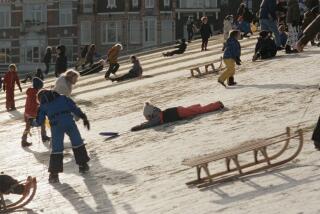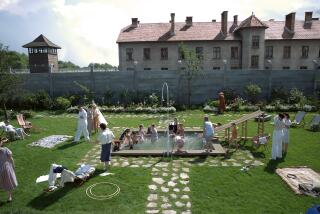A glorious and terrible history
- Share via
“The Capital of Refugees” is the name the Greek novelist Giorgos Ioannou gives Salonika, the Hellenistic, Roman, Byzantine, Ottoman, Jewish and now Greek city situated on the Via Egnatia, the Roman road that led from Italy into Anatolia. Named for Alexander the Great’s half-sister, Thessalonike, Salonika was an umbilical center of trade between the Mediterranean and Central Europe and was destined to be a ville fatale -- the object, throughout its history, of ambitious makers of empires both temporal and spiritual. Nearby, St. Paul made his first European converts; his first epistle to the Thessalonians contains imagery underpinning the currently fashionable Rapture theology. Salonika was also the rose that God offered to the Ottoman Sultan Murad II in a dream; Murad would go on to conquer it in 1430, the year in which this superb, elegiac and essential biography of the city opens.
For the Iberian Jews whom the sultan invited to settle within his borders after their expulsion from Spain in 1492, Salonika was the “Jerusalem of the Balkans.” As late as 1912, they were the largest ethnic group in Salonika, and the city docks came to a standstill on the Jewish Sabbath. Mustafa Kemal (later known as Kemal Ataturk, founder of the Turkish republic), lamented to a friend, “How could you leave Salonika, that beautiful hometown of ours?” after the Greeks claimed the city in 1912. For the historian Mark Mazower, however, Salonika is a “city of ghosts.”
Salonika has engaged Mazower’s attention since he first visited it as a backpacking student more than 20 years ago. In the ensuing decades of fruitful preoccupation with a place he clearly relishes, he “noticed how seldom standard Greek accounts of the city referred to the Jews,” while the “imagined city” of Jewish scholarship “was as empty of Christians as the other was of Jews. As for the Muslims, who had ruled Salonika from 1430 to 1912, they were more or less absent from both.” Here too were the Ma’min, a sect of Marrano Jews who embraced Sabbatai Zevi, the 17th century messiah from Smyrna, and followed him into Islam when he converted. In an ironic sense, his messianic claim turned out to be true: Not only did the Ma’min become a highly successful component of Salonikan society, but they were deported to Turkey during the Muslim-Christian population “exchanges” in 1923 and thus were spared an encounter with the Nazis, who occupied Greece during World War II.
Using various archival sources -- records that surfaced in Istanbul’s Topkapi Palace in the 1940s; 18th century diaries; “dusty unopened sacks of documents” in Athens detailing actions of the “Service for the Disposal of Israelite Property,” which the Germans organized in the brief time it took to deport a fifth of Salonika’s population to Auschwitz -- Mazower unearths surprising, invisible Salonikas. In a remarkable display of historical craftsmanship, he resurrects the city’s manifold ghosts, so notorious for their presence that exorcisms of newly acquired houses occurred even in the 20th century.
Mazower brings Ottoman Salonika to life, with its minaret-studded skyline and houses ornamented with verses from the Koran. The minarets would be destroyed after the Greek victory in 1912, a decision described several years later by a former Greek prime minister as an act of “coarse [and] mindless chauvinism.” The Sephardic Jews who arrived in the 15th and 16th centuries created a miniature Iberia, still intact and Spanish-speaking in 1892, according to the Spanish journalists who visited the city that year to mark the 400th anniversary of the expulsion. The Ottomans administered the city, while the Jews ran its economy, taking advantage of their diaspora connections throughout the Mediterranean and becoming the Ottomans’ favored minority. Mazower notes that they “combined commerce with espionage and ran the best intelligence networks in the entire region.”
Under the Ottomans, Salonika’s society was organized along hierarchical but not completely inflexible religious lines, with Christians “constantly reminded that theirs was a second-class faith.” Clerics had almost dictatorial power over their religious communities, governing them according to each sect’s laws and acting as tax collectors, with far-reaching and startling cultural consequences. Rabbis could paralyze the local economy by occasionally threatening excommunication of Jews who traded with Christians. Glass windows were not a welcome innovation, because of Muslim fears that their households’ women would be exposed to the gaze of strangers; newspapers also were late arrivals, “held back by the obstructive attitude of the local rabbinate.” Salonika’s diverse communities produced little if any secular literature of significance, though there has been a late flowering in the 20th and 21st centuries.
Mazower’s profound commitment to scholarship compels him to ask painful questions. He confronts the lack of discussion in Greece about the compulsory departure of Salonika’s Muslims in 1923, concluding that “[t]heir experiences are still overshadowed in the public mind by the simultaneous suffering of the Greek refugees who took their place.” He examines the diverging political interests and social ambitions of the Ottoman Jews, who were deeply loyal to the empire, and the Greeks, ambitious for their own state, in recounting the troubled relations between them. And he notes the consequences to “a city’s consciousness of itself -- especially to a city so proud of its past -- when substantial sections were at best allowed to crumble away, at worst written out of the record.”
Salonika was a city of truncated cosmopolitanism. “The most diverse civilizations shared [the city] but did not penetrate one another,” a local scholar wrote in 1914. The Nazis marveled that Salonika’s Jews had never been shut up in a ghetto -- but, in a sense, each of the city’s communities was itself a ghetto. “Jews, Orthodox, Donmehs [the followers of Zevi], Muslims lived side by side, without mixing, each shut in its community, each speaking its language,” wrote the same scholar. A city newspaper of 1911 described Salonika as “a juxtaposition of tiny villages.” The vision of a less stratified social world came too late, when the region was already splitting into the relatively homogenous ethnic nation-states of today. The Muslims of Greece and the Christians of Turkey would experience their own bitter expulsions, exiled from their homelands in the compulsory population exchange of 1923. Fewer than 5% of Salonika’s Jews survived the Nazi deportations, and with that, the last of the polyglot, ethnically and religiously complex Ottoman Salonika was destroyed.
The Salonika that we know today is, paradoxically, an entirely new city -- a “contemporary icon of antiquity,” in Mazower’s brilliant phrase, “a symbolic space ... defined and redefined by its political masters.” He describes a fascinating process of reconstruction, in which (with additional help from a devastating fire in 1917) Greek archeologists and historians set out to create “new forms of historical memory,” redesigning the city to emphasize its classical and Byzantine past.
Mazower resolutely examines the processes of selective scholarship: Archeologists, he tells us, published learned articles about the ancient inscriptions on the reverse side of Jewish tombstones, while ignoring the inscriptions in Hebrew, Portuguese or Spanish. State funds were not assigned to Ottoman sites until the 1980s, while Greek history books presented an image of a country whose sense of Hellenistic identity was eternal, instead of examining its complex evolution. “Nation-states,” writes Mazower, “construct their own image of the past to shore up their ambitions for the future; forgetting the Ottomans was part of Greece’s claim to modernity.”
Without melodrama or moral exhibitionism, Mazower’s scrupulous witness to the experiences of each major group that made up the fabric of Salonika is an act of compassion for their suffering, a recognition of their gifts and aspirations, an acknowledgment of their common humanity. His account of what the Muslims created in Salonika -- and what they too endured, as they were forced from their homes -- gives weight to his criticism of a “fundamentally instrumental conception of history” that functions in the service of ideology. In a way, his book is a fragment of the Salonika that might have been. Paul, the saint so intimately associated with the city, may have most aptly described this quality of work: Mark Mazower is a scholar who “rejoices in the truth.” *
More to Read
Sign up for Essential California
The most important California stories and recommendations in your inbox every morning.
You may occasionally receive promotional content from the Los Angeles Times.










